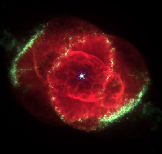

|
FUSE
Frequently Asked Questions
About Reaction Wheels
|

On December 10, 2001, the FUSE satellite suspended science operations temporarily because of
problems with the reaction wheels on the spacecraft. Here is supporting information about these
devices and how they are used to control and point the telescope.
NEWS FLASH: FUSE is back in business!
- What are Reaction Wheels?
Reaction wheels, or momentum wheels as they are sometimes called, are devices used on many satellites
to hold the satellite steady (when desired) or move the pointing direction from one place to another
(a procedure called `slewing'). FUSE does not carry any kind of rocket or gas jets to move us around
the sky from object to object. We move about using reaction wheels, which exert torque forces on
the satellite and control its pointing direction. Reaction wheels are part of what is called the
"Attitude Control System" or ACS.
- How does a reaction wheel work?
A reaction wheel is basically just a spinning flywheel mounted on a central bearing whose rate of
rotation can be adjusted as necessary by an electric motor to apply a force and move the spacecraft.
(The electricity comes from our solar panels.)
Since the satellite is floating freely in space, any change in the rate of spin of these wheels
creates a predictable force that nudges the satellite's pointing direction.
By arranging three reaction wheels on perpendicular axes and combining the torques appropriately, we
can "push" our telescope around to look wherever we want it to! Once in position, very tiny changes
in spin rates (which produce very tiny corrective "pushes") work to keep us pointing at the object of interest.
In practice, many satellites (including FUSE) can use four reaction wheels simultaneously: three mounted
perpendicular to each other and a fourth mounted at an angle to the other three. There are practical
reasons for this (that have to do with keeping all of the wheel speeds within a certain range), but
basically any three wheels are needed for full control of pointing direction on the sky. Hence, the
fourth wheel also provides redundancy in case one of the wheels fails. The problem on FUSE at the moment
is we have had two wheels stop operating, leaving us with only two spinning wheels!
- Sounds pretty serious. What can you do now?
When we dropped down to two reaction wheels on December 10th, we could not point the telescopes and
perform science observations in a safe manner. Hence, we safed the telescopes and detectors while
we worked to get FUSE operational again. FUSE was back in limited science operations by Jan. 27, 2002,
and resumed full-time science operations about March 1.
We continue trying to get at least one of the errant wheels spinning again, but so far to no avail.
This activity will coninue from time to time in hopes of getting one of the wheels spinning again.
The second thing we have done is to develop an alternate way to control our pointing.
I don't know about you, but I've always been amazed when I hear about engineers fixing a problem
on some distant spacecraft. Well, now I've experienced it firsthand! It is truly amazing how
resourceful and clever these people can be, even when they can't get their hands on the spacecraft.
The alternative method of controlling the motions involves devices called
"magnetic torquer bars" (or MTBs for short). These devices are basically electromagnets and are normally
used in a "support" mode by the ACS system, but are not used for actually pointing the satellite.
We developed a way of using these devices to actively point the telescope and help hold it
steady. We are using the MTBs to "push" and "pull" against the earth's magnetic field. If you
have ever seen the needle of a compass swing around and point north, it is the same idea (only with
stronger magnets!). We have already demonstrated that they can be used to provide fine control
(needed for science observations) on the third axis of motion as we point over about half of the sky.
Further work is being done to refine and test the control software to provide more coverage.
Date of last change: Mar. 8, 2002

|


